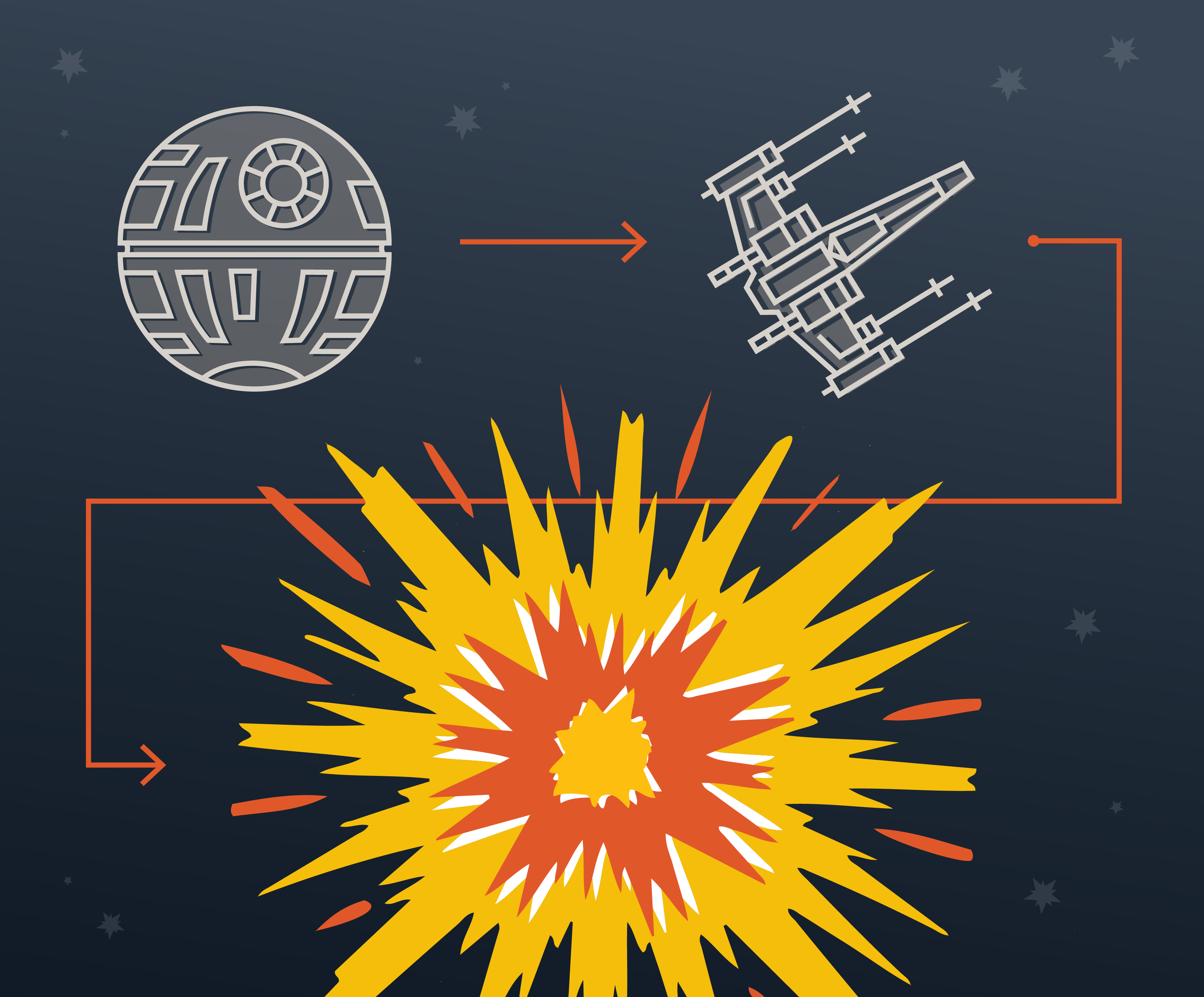
Working in a technical field it’s easy to take certain habits for granted. I’m frequently startled to rediscover how little thought most people put into what they do. They don’t think ahead, don’t prioritize, they just… do things, assuming that as long as they’re pointed in the right general direction and moving they’ll get where they want to go.
This attitude is a great source of amusing anecdotes and mild annoyances in daily life but is absolutely lethal on a project of any size or importance. As a responsible parent, this is exactly the kind of chaos I hope to avoid by instilling the right life lessons early. And everything has a lesson in it, if you’re willing to be the one sucking fun out of the room.
So, let’s talk about the Death Star Project.
Is what you’re trying to do even worth doing?
Nobody needs a battle station the size of a moon that can blow up a planet. Whatever your ultimate goals are, there are better ways to get there. I won’t bore you with the math, but the material to construct the Death Star would have built at least 7 million Star Destroyers. (Remind me to explain the square-cube law later.) Any one of which could wipe out all life and resources on a planet within a day or so.
The purpose of the Death Star was to so thoroughly terrify the galaxy that no planet would dare step out of line. (And the reason for that was because building enough ships to police the whole galaxy would be too expensive!) But which do you find more terrifying – the one Death Star or a few hundred of those Star Destroyers parked in every inhabited system in the galaxy? Which would be harder to destroy?
Don’t just go with the first idea that sounds cool. Think it through. Is it really the best solution?
Have you thought through all your requirements?
The builders of the Death Star had two main requirements – it had to be powerful and it had to be impressive. I think we can agree they nailed those. But they focused on them so exclusively that their design sacrificed defense, resilience and practicality. They met the criteria they were given, but at the expense of their overall goals. The galaxy isn’t terrified of a ring of debris in orbit around Yavin IV.
Don’t assume any requirements you’re given are complete. Think about the big picture to identify any unspoken needs. It’s not enough to focus on your top priority at the expense of everything else that’s important.
Have you identified all your risks?
Oh that exhaust port. The Imperial leadership was absolutely convinced that the Death Star was invulnerable, so they weren’t very motivated to look for vulnerabilities. And you’re unlikely to find what you aren’t looking for.
Always ask what could go wrong. If there are potential problems with what you’re doing you need to know what they are so you can see them coming.
What are your backup plans?
Those potential problems are suddenly actual. Now what? On the Death Star, a whole lot of nothing good. They never believed they could be in danger from small ships, so when it turned out they were they didn’t have enough of the appropriate defenses. They never believed they could be in danger, period, so they had no fleet backup on standby, no evacuation plans. The only outcome they planned for was success. The upside to being that wrong is they weren’t around to regret it.
It’s not enough to know what might go wrong, you need to think about what you’ll do if it does.
Is everyone on board?
Projects are hard enough without your own team working against you. Sabotage was an ongoing problem throughout the construction of the Death Star, in no small part due to the use of slave and prisoner labor. The Rebellion got its hands on schematics and project documents on multiple occasions, always with inside assistance, and those leaks led to the discovery of the flaw that took down the station.
Make sure everyone involved is willing to work with you. If not, find a way to motivate them. (No, not that way.)
Are you communicating with your team?
Some engineer, somewhere, had concerns about that exhaust port. Or the lack of surface defenses capable of handling small fighters effectively. But they obviously didn’t feel comfortable raising it to the attention of management. Can you blame them? Best case scenario, they’re the one standing in front of Darth Vader while he’s venting his frustrations. Worst case scenario they actually get blamed for it.
Be willing to listen to your team, whether they have fresh ideas or just information you need to have. Make sure they know it.
Have you tested it?
I’m sure the Death Star team did basic happy path testing. They took it for a spin around the sector. They test-fired the superlaser. (R.I.P. Alderaan.) But I don’t think they tried to break it. If they had, if there was a war game, if a dedicated red team was tasked with attacking the station, the exhaust port vulnerability would never have been a surprise.
Always test it before you depend on it. If you haven’t tested it, you’re not done.
These are questions you should be keeping in mind when doing anything, really. But now, if you’re ever building a device of planetary-level destruction (and I certainly wouldn’t put it past my kids) I expect you to do better than the Empire at the bare minimum.
Loved the article? Hated it? Didn’t even read it?
We’d love to hear from you.




